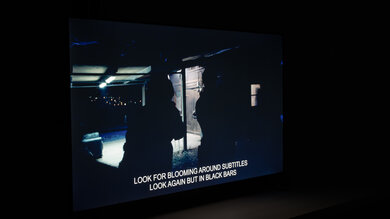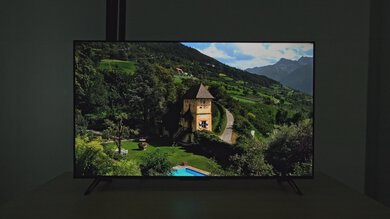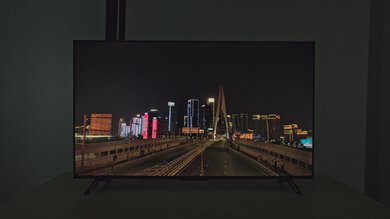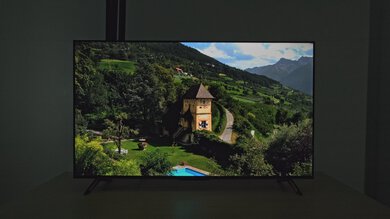The TCL Q5/Q550F QLED is TCL's lowest-tier Q-series TV, below the TCL Q6/Q650G QLED and the TCL Q7/Q750G QLED. Unlike these models, the Q550F uses Amazon's Fire TV as its operating system. This TV is sold in parallel with the TCL Q5/Q550G QLED, which uses Google TV. It's a simple TV, but it does have a few extra features, such as three 4k @ 60Hz HDMI ports with variable refresh rate (VRR) support. Also, sizes 55 inches and above have TCL's Game Accelerator 120 feature for 1440p @ 120Hz gaming.
It supports Dolby Vision HDR and can passthrough some Dolby and DTS advanced audio formats. It doesn't have hands-free voice control, but its remote has an integrated microphone through which you can interact with Amazon Alexa. It has built-in Apple AirPlay 2 and Google Chromecast, so you can seamlessly stream your videos using your phone. We bought and tested the 50-inch model, but it's available in five other sizes: 43, 55, 65, 75, and 85 inches. The 43-inch model is a Canadian-only variant available from different retailers.
Our Verdict
The TCL Q550F is an okay TV for mixed usage. The TV's contrast is decent, but its HDR brightness is just alright, so it's not very good for dark room usage or for watching HDR content as bright highlights don't really pop, and blacks are raised whenever bright highlights are on screen. On the other hand, its SDR brightness is quite decent, and it has good reflection handling, so it's a solid pick for watching SDR content in a moderately lit room. Unfortunately, the TV has a narrow viewing angle, so it's not a good choice to use in a group setting. The smaller sizes of the TV are barebones when it comes to gaming features, although it does have VRR. Sizes bigger than 50 inches have some modern gaming features like 1080p/1440p @ 120Hz, with a wider VRR range.
-
Good reflection handling.
-
Narrow viewing angle.
-
No local dimming feature.
The TCL Q550F is alright for watching TV shows during the day. The built-in Fire TV smart interface comes loaded with a huge selection of streaming apps, so it's quick and easy to find your favorite shows. It also has Apple AirPlay 2 and Google Chromecast built-in, making casting a show directly from your phone a breeze. While its SDR brightness is only decent, it does have good reflection handling, so it's capable of handling some glare, especially from ambient sources of light. Unfortunately, the TV has a narrow viewing angle, so it's not a good choice for watching shows in a group setting, as anyone not directly in front of the TV has to watch a degraded image. It also has inadequate processing features, so if you watch lower-quality streams or shows on DVD, they aren't as smooth and sharp as they could be.
-
Good reflection handling.
-
Narrow viewing angle.
-
Poor low-quality content smoothing.
The TCL Q550F is okay for watching sports during the day. The TV has a good response time, so fast motion is clear and easy to see, with very little blur around fast-moving balls and players. It has decent peak brightness in SDR with good reflection handling so that visibility isn't an issue in moderately lit rooms, especially if you avoid glare from direct sources of light. On the other hand, it has a narrow viewing angle, so it's not a good choice for watching the game with friends, as anyone seated to the sides of the screen sees a degraded image.
-
Good reflection handling.
-
Narrow viewing angle.
The TCL Q550F is a good TV for gaming. It has a good enough response time that fast motion in games is clear, with very little blur or ghosting behind quick-moving objects. The TV has incredibly low input lag that provides a very responsive feel, and this model also supports VRR, so there is almost no screen tearing. Unfortunately, it has no ports capable of HDMI 2.1 bandwidth, so you can't play in 4k @ 120Hz. However, it supports up to 1440p @ 120Hz on the bigger models, so you can play at a higher frame rate if you prefer performance over image quality.
-
VRR support.
-
Very low input lag.
-
No HDMI 2.1 bandwidth.
The TCL Q550F is alright for watching HDR movies in a dark room. It has decent contrast but lacks a local dimming feature, so blacks aren't deep or inky when bright highlights are present on screen. It does, however, get bright enough for some minor highlights to stand out in HDR, but it's better suited for watching SDR movies due to its decent SDR brightness. Its color accuracy in SDR is mediocre without being calibrated, which is good enough for most people, but those who really care about accuracy won't be satisfied with this TV's performance out of the box.
-
Excellent PQ EOTF tracking.
-
Dolby Vision support.
-
Poor low-quality content smoothing.
-
No local dimming feature.
-
Doesn't remove 24p Judder from most content.
The TCL Q550F is very good for HDR gaming, even if HDR adds very little due to the TV's barely decent HDR brightness and contrast; it provides a pleasant enough gaming experience, but bright highlights don't really pop, and dark scenes look washed out when bright highlights are on screen. Still, it has low input lag, so it delivers a responsive gaming experience. It also has a good enough response time that you don't have much blur or ghosting around quick-moving objects on the screen. If you're buying one of the bigger models then you have access to 1440p @ 120Hz gaming, with a wide VRR range, alongside 4k @ 60Hz.
-
VRR support.
-
Very low input lag.
-
Dolby Vision gaming @ 60Hz.
-
No local dimming feature.
-
No HDMI 2.1 bandwidth.
The TCL Q550F is a good TV to use as a PC monitor. Due to its incredibly low input lag and very good response time, cursor movements are smooth and responsive, with little motion blur. When set to Game Mode, the TV displays chroma 4:4:4 signals properly, which is essential for clear text from a PC. It has decent SDR peak brightness and good reflection handling, so it does deal well with glare, especially from ambient sources of light, as it struggles a bit with glare from lights or windows placed directly opposite the screen. Unfortunately, it has a narrow viewing angle, so the sides of the screen aren't consistent with the middle when you sit close.
-
Good reflection handling.
-
Very low input lag.
-
Ability to display chroma 4:4:4 for clear text when in Game Mode.
-
Narrow viewing angle.
- 6.9 Mixed Usage
- 6.5 TV Shows
- 6.7 Sports
- 7.7 Video Games
- 6.8 HDR Movies
- 7.9 HDR Gaming
- 7.5 PC Monitor
Changelog
-
Updated Feb 10, 2025:
We retested the TV's HDR format support and determined it doesn't support HDR10+. We updated the introduction and the results and text in the Inputs Specifications section to reflect this.
- Updated Nov 28, 2024: Review published.
- Updated Nov 26, 2024: Early access published.
- Updated Nov 18, 2024: Our testers have started testing this product.
- Updated Nov 06, 2024: The product has arrived in our lab, and our testers will start evaluating it soon.
Check Price
Differences Between Sizes And Variants
We bought and tested the 50-inch TCL Q5/Q550F QLED (50Q550F), but these results are also valid for the 43-inch model (43Q550F-CA), which is exclusive to the Canadian market. Models bigger than 50 inches perform a bit differently since they have TCL's Game Accelerator Feature 120, but we expect most of our results to be applicable to those sizes as well. The Q550F is a variant of the TCL Q5/Q550G QLED, which is equipped with Google TV. Outside of the smart OS, both models are nearly identical, although the Q550F can passthrough advanced DTS audio formats through eARC. The 75- (75Q550F) and 85-inch (85Q550F) models also come with four HDMI ports instead of three on the smaller sizes, as well as slightly different feet.
| Size | US Model | Canadian Model | Game Accelerator 120 | HDMI ports |
|---|---|---|---|---|
| 43" | - | 43Q550F-CA | No | 3 |
| 50" | 50Q550F | 50Q550F-CA | No | 3 |
| 55" | 55Q550F | 55Q550F-CA | Yes | 3 |
| 65" | 65Q550F | - | Yes | 3 |
| 75" | 75Q550F | - | Yes | 4 |
| 85" | 85Q550F | - | Yes | 4 |
See our unit's label.
Compared To Other TVs
Much like the Google TV TCL Q5/Q550G QLED, the TCL Q550F, while unspectacular, is a good performer for its price. For gamers, it's especially interesting in sizes bigger than 50 inches, as it then comes with TCL's Game Accelerator 120 feature, enabling 1080p and 1440p gaming at 120Hz, with a wide VRR range. For everyone else, this product is functional and offers an okay performance overall. It's basically identical to the Q550G, so get the one with the Smart OS you prefer. If you're looking for better image processing, you could opt for the slightly better TCL Q6/Q651G QLED or the superior Hisense U6/U6N, although the latter can't play games at 120Hz with VRR enabled simultaneously.
For more options, check out our recommendations for the best budget TVs, the best QLED TVs, and the best gaming TVs.
The TCL S551G and the TCL Q550F are very similar, although the S551G uses Google TV while the Q550F uses Amazon's Fire TV OS. The Q550F has the better contrast and is the brighter of the two TVs, but the S551G has a wider viewing angle, making it better suited for wide seating arrangements. It also has the slightly better image processing overall.
The TCL Q651G and the TCL Q550F are very similar, and you should get the cheapest one you can find, or get the model with your preferred smart operating system, as the Q651G uses Google TV while the Q550F uses Amazon's Fire TV OS. When it comes to performance, the Q550F has the better contrast of the two and is also a bit brighter with better reflection handling. The Q651G is the more accurate of the two TVs, with generally better image processing.
The TCL Q550F and the Hisense QD65NF are similar in many ways, with the TCL having a slight edge overall. The TCL is by far the better gaming TV, as it has a faster response time, lower input lag, and a VRR feature. In its bigger sizes, it also supports up to 1440p @ 120Hz with a wider VRR range. The TCL also has slightly better contrast and is brighter than the Hisense, although the latter has a wider color gamut and a slightly wider viewing angle.
The TCL Q5/Q550G QLED and the TCL Q5/Q550F QLED are basically interchangeable, with the primary difference being their operating systems; the Q550G uses Google TV, while the Q550F uses Amazon's Fire TV OS. Otherwise they perform more or less the same, although the Q550F has better reflection handling while the Q550G has a wider viewing angle. The Q550F also passes through advanced DTS audio formats through eARC.
The Hisense U6N is better than the TCL Q550F. The Hisense's contrast is much better due to its local dimming feature, which also lets it emphasize bright highlights in HDR in a way that the TCL just can't. It also has better image processing than the TCL, with superior SDR brightness, delivering better image quality overall. In its biggest sizes, the TCL does 1080p and 1440p gaming at 120Hz with VRR, while the Hisense can do 120Hz and VRR, but not at the same time. Still, it does have lower input lag than the TCL, with a slightly faster response time.
Video
Test Results
The back of the TV is very plain, looks cheap, and is identical to the backs of the TCL Q5/Q550G QLED and the TCL Q6/Q650G QLED. The inputs are housed in a larger section on the back, near the center of the TV. Unfortunately, the TV doesn't come with any accessories for cable management.
The TV has okay build quality. There's a bit of flex in the metallic upper section of the back, with more noticeable flex in the middle section of the back around the VESA mounts, but this is common and won't cause any issues.
Our unit has a dark spot on the bottom left of the screen, which is noticeable in our PS5 configuration photo. The upper right corner of our unit is chipped, with a small hole in the bezel.
This TV doesn't have a local dimming feature, so it can't adjust individual zones to brighten up highlights without impacting the rest of the image. This means that there are no distracting flicker or brightness changes as bright highlights move between dimming zones, as it doesn't have any.
The TCL Q550F has passable HDR brightness. It isn't bright enough to really make specular highlights pop. Even in darker scenes, highlights aren't too impactful because of the TV's limited contrast and lack of local dimming.
With 'HDR Enhancer' set to 'On,' the TV's brightness is slightly lower, and we recommend leaving it disabled. For reference, you can see the results with 'HDR Enhancer' enabled below:
- Hallway Lights: 314 cd/m²
- Yellow Skyscraper: 260 cd/m²
- Landscape Pool: 240 cd/m²
The HDR brightness in Game Mode is okay, and there is no noticeable difference in brightness between Movie Mode and Game Mode.
With 'HDR Enhancer' set to 'On,' the TV's brightness is slightly lower, and we recommend leaving it disabled. For reference, you can see the results with 'HDR Enhancer' enabled below:
- Hallway Lights: 322 cd/m²
- Yellow Skyscraper: 255 cd/m²
- Landscape Pool: 251 cd/m²
The PQ EOTF tracking on the TV is truly excellent. Midtones are a little dimmer than they should be, bright highlights are slightly too bright, and blacks are raised, but aside from that, the TV's brightness closely follows the curve and tracks the content creator's intent well. There is a very slight roll-off with all mastered content, which preserves some fine detail in really bright content.
The TV gets decently bright in SDR. It's not ideal for very bright rooms, but it overcomes glare in moderately lit rooms, especially with good reflection handling.
The TV has a very good color gamut, although with noticeable color mapping issues throughout. Still, it has excellent coverage of the commonly used DCI-P3 color space, although most colors are undersaturated and greens lean too yellow. The TV adequately covers the wider Rec. 2020 color space, but here, colors are even more undersaturated, with greens and purples deviating from what they should be.
The TV has decent color volume in HDR. Unfortunately, it struggles to represent darker colors due to its lack of local dimming. It also doesn't display most colors at very high luminance levels.
The TCL Q550F has mediocre pre-calibration accuracy in SDR. Its biggest issue is its disappointing white balance, as blues and especially reds are notably overrepresented in all shades of gray except blacks. This makes the TV's color temperature lean a bit too warm overall. Color accuracy fares a bit better, although here, all colors deviate slightly from what they should be, more so for reds, blues, and whites. Gamma is close to our target of 2.2, although brighter scenes are noticeably too bright.
The TV's accuracy after calibration is excellent. It's easy to calibrate, although the TV doesn't have a color calibration mode, so any adjustments are limited to the TV's white balance. This shows up in the results, as the TV's white balance and color temperature are now almost perfect, while color accuracy still shows noticeable color mapping issues, and colors still aren't quite what they should be.
The TV also defaults to using a 'Native' color space, thus most of its colors end up oversaturated in the Rec. 709 color space.
See our full calibration settings.
The TV's gray uniformity is mediocre overall, although it's quite good on very dark screens, as here the sides are just a tad lighter than the center. On a lighter uniform screen, the TV's uniformity is notably worse, as the entire right side of the screen is darker than the left side. This is noticeable in certain content, like hockey with its all-white rink, leading the right side of the rink to look darker than the left.
The TV's viewing angle is inadequate and isn't a good choice for wide seating arrangements. There's significant color shifting and brightness loss as you move off-center, and the image looks increasingly washed out as you move further away to the sides.
The TCL Q550F has good reflection handling. Its semi-gloss screen does an excellent job of reducing the intensity of indirect reflections, but it has a harder time with direct reflections from light sources positioned in front of the screen.
The TV has mediocre HDR gradient handling. There's noticeable banding in almost every shade except brighter reds and blues, and it's particularly bad in darker grays.
The TCL Q550F uses a BGR (Blue-Green-Red) subpixel layout instead of the traditional RGB layout. It doesn't cause any issues for video content, but if you plan to use it as a PC monitor, non-RGB subpixel layouts impact text clarity, and text looks slightly blurry.
The TV uses a KSF phosphor coating to produce red light and a quantum dot color converter to produce green light, as confirmed by the TV's spectral power distribution (SPD).
This TV doesn't have an optional backlight strobing feature, commonly known as black frame insertion (BFI).
The TCL Q550F has some minor stutter when watching movies or TV shows shot at 24 fps, which is most apparent in slow panning shots, but it performs well overall.
The TCL Q550F removes 24p judder from native sources, like apps, but it can't properly remove judder from external 24p signals, like Blu-ray players. Unfortunately, it can't remove judder from 60Hz sources like most cable TV boxes and older streaming devices that lack a Match Frame Rate feature.
The TV supports every VRR technology to reduce screen-tearing. Still, its usefulness is limited due to its narrow range, and it doesn't support sources with Low-Frame-Compensation (LFC), so you get screen-tearing when your frame rate dips below 48 fps.
The TCL Q550F has incredibly low input lag when set to Game Mode, which ensures a very responsive gaming experience with very little delay between your actions with your controller or mouse and the action on-screen.
The TV supports most resolutions up to 4k @ 60Hz. It's also worth noting that we couldn't get it to scale 480p sources properly when displayed via PC, but it does properly display native 480p sources like a DVD played on a DVD player. It displays proper chroma 4:4:4 when set to Game Mode.
The TCL Q550F can't take full advantage of the PS5, as it doesn't support 120Hz at any resolution in its smaller sizes; models above 55 inches support 120Hz at 1080p and 1440p. Still, it does have VRR for a nearly tear-free gaming experience. The TV supports Auto Low Latency Mode, so you don't have to worry about manually switching to Game Mode to get the lowest input lag.
The TCL Q550F can't take full advantage of the Xbox Series X|S, as it doesn't support 120Hz at any resolution in its smaller sizes; models above 55 inches support 120Hz at 1080p and 1440p. Still, it does have VRR for a nearly tear-free gaming experience, and the TV supports Auto Low Latency Mode, so you don't have to worry about manually switching to Game Mode to get the lowest input lag. It also supports Dolby Vision gaming.
This TCL Q550F is limited to HDMI 2.0 bandwidth on its three HDMI ports. It supports Dolby Vision but not HDR10+. Unfortunately, the tuner is limited to ATSC 1.0, so you can't stream 4k content over the air.
The TV supports eARC, which lets you pass high-quality, uncompressed audio to a compatible receiver or soundbar through an HDMI cable. It supports all major audio formats, so you don't have to worry about compatibility with external sources.
The TCL Q550F has a poor frequency response. TV speakers tend to lack bass, and this TV is no different, as there's no thump and rumble at all. It also can't get loud at all, so it's unsuitable for noisy environments. The TV has little pumping or compression artifacts at max volume, but other than that, it doesn't sound great, with unbalanced sound across the board.
This TV's handling of sound distortion is mediocre. Distortion handling is decent at moderate levels, but it gets more noticeable at the TV's max volume.
The TV has a wide selection of apps, so it's easy to find your favorite content. You can also cast content from your phone onto the TV or play videos directly from a USB stick.
The TV's remote is medium-sized and has a simple layout. It has a series of dedicated buttons for the most popular streaming apps. The remote has an integrated microphone for voice commands, so you can change inputs, search within apps, and ask for the weather and time. Unfortunately, you can't use your voice to adjust settings like brightness.

































































































